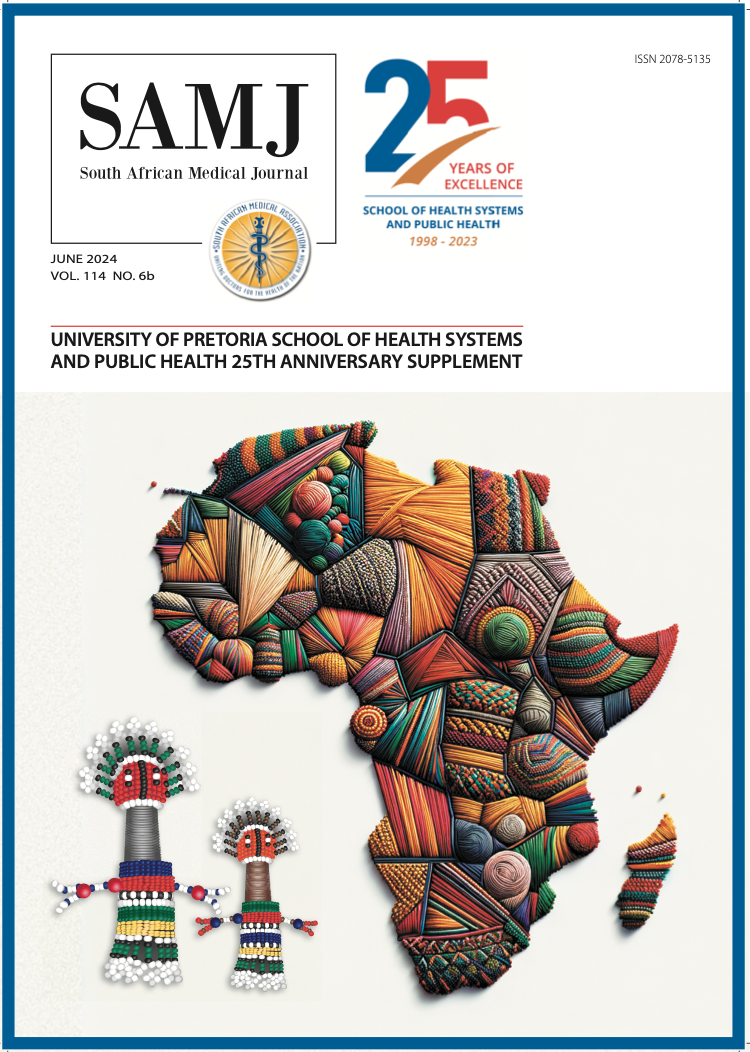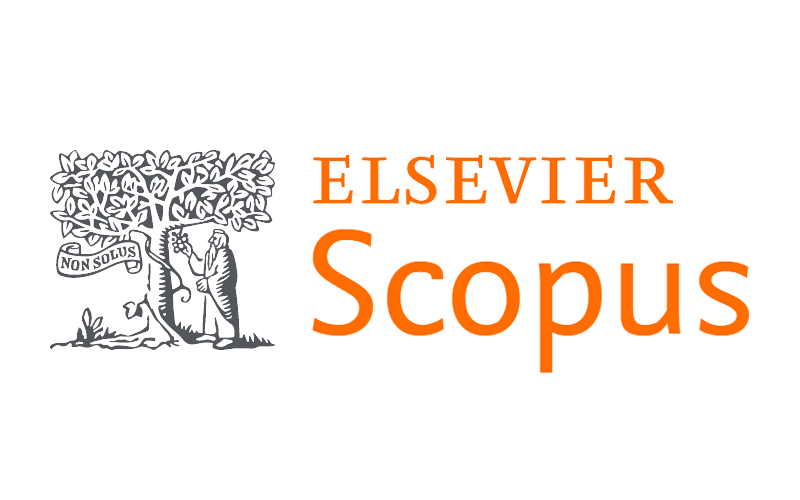Knowledge of pregnant women regarding prevention of mother-to-child transmission of HIV infection in Gert Sibande District, Mpumalanga Province, South Africa: A qualitative study
DOI:
https://doi.org/10.7196/SAMJ.2024.v114i16b.1336Keywords:
Prevention, Mother-to-child transmission, HIV infection, Knowledge, Attitudes, Behaviours,MTCT,PMTCT, Gert Sibande, South Africa, KAP.Abstract
Background. Prevention of mother-to-child transmission (PMTCT) of HIV helps in closing the gaps for new HIV infections, thereby contributing to achieving the global targets of an AIDS-free generation.
Objective. To explore knowledge regarding PMTCT among pregnant women in Gert Sibande District, Mpumalanga Province, South Africa (SA).
Methods. The study was performed in two clinics in Chief Albert Luthuli Municipality, Gert Sibande District. It was a qualitative and descriptive exploratory study involving in-depth, one-on-one interviews with pregnant women regarding their PMTCT knowledge and perspectives.
Results. The study findings showed that pregnant women from the two clinics have a good knowledge of PMTCT. However, they were not aware that caesarean section can minimise mother-to-child transmission (MTCT) of HIV infection.
Conclusion. PMTCT is important in establishing an HIV-free generation. The study revealed that women had a good understanding of MTCT; nevertheless, additional education is necessary, particularly regarding birthing procedures that minimise the risk of MTCT.
References
UNAIDS: Joint United Nations Programme on HIV/AIDS. The path that ends AIDS: UNAIDS global update 2023. Geneva: UNAIDS, 2023. https://www.unaids.org/en/resources/documents/2023/global- aids-update-2023 (accessed 10 April 2024).
World Health Organization. Global HIV programme: Mother-to-child transmission of HIV. Geneva: WHO, 2024. https://www.who.int/teams/global-hiv-hepatitis-and-stis-programmes/hiv/ prevention/mother-to-child-transmission-of-hiv#:~:text=Globally%2C%20an%20estimated%20 1.3%20million,from%2015%25%20to%2045%25 (accessed 11 April 2024).
WesselsJ,ShermanG,BamfordL,etal.TheupdatedSouthAfricannationalguidelinefortheprevention of mother-to-child transmission of communicable infections. South Afr J HIV Med 2020;21(1):1079. https://doi.org/10.4102/sajhivmed.v21i1.1079
MassynN,BarronP,DayC,NdlovuN,PadarathA.DistrictHealthBarometer2018/19.Durban:Health Systems Trust, 2020. https://www.hst.org.za/publications/District%20Health%20Barometers/DHB%20 2019-20%20Complete%20Book.pdf (accessed 11 April 2024).
Daniels B, Spooner E, Coutsoudis A. Getting to under 1% vertical HIV transmission: Lessons from a breastfeeding cohort in South Africa. BMJ Global Health 2022;7(9):e009927. https://doi.org/10.1136/ bmjgh-2022-009927
Woldesenbet SA, Lombard C, Manda S, et al. The 2019 National Antenatal Sentinel HIV Survey, South Africa. Pretoria: National Department of Health, 2021:138. https://www.nicd.ac.za/wp-content/ uploads/2021/11/Antenatal-survey-2019-report_FINAL_27April21.pdf (accessed 11 April 2024).
ButheleziSF,ModesteRRM,PhetlhuDR.Barrierstothemanagementofchildrenunderfiveexposedto HIV in the rural areas of South Africa. Curationis 2021;44(1):e1-e12. https://doi.org/10.4102/curationis. v44i1.2073
Ntsime NR, Makhado L, Sehularo LA. Barriers in implementing the PMTCT in Moretele Sub-District, South Africa: An exploratory study. Health Serv Insights 2022;15:11786329221083439. https://doi. org/10.1177/11786329221083439
Okoli JC, Lansdown GE. Barriers to successful implementation of prevention of mother-to-child transmission (PMTCT) of HIV programmes in Malawi and Nigeria: A critical literature review study. Pan Afr Med J 2014;19:154. https://doi.org/10.11604/pamj.2014.19.154.4225
Eshetu HB, Kebede N, Bogale EK, et al. Knowledge of prevention of mother-to-child transmission of HIV among reproductive age women in high HIV/AIDS prevalent countries: A multilevel analysis of recent demographic and health surveys. PLoS ONE 2023;18(10):e0292885. https://doi.org/10.1371/ journal.pone.0292885
United Nations Development Programme. Sustainable Development Goals 2030. Geneva: UNDP, 2023.
https://www.undp.org/sustainable-development-goals/good-health (accessed 10 April 2024).
Yeshaneh A, Abebe H, Tafese FE, Workineh A. Knowledge, attitude, and practice towards prevention of mother-to-child transmission of HIV among antenatal care attendees in Ethiopia, 2020. PLoS ONE
;18(2):e0277178. https://doi.org/10.1371/journal.pone.0277178
Sia D, Onadja Y, Hajizadeh M, Heymann SJ, Brewer TF, Nandi A. What explains gender inequalities in
HIV/AIDS prevalence in sub-Saharan Africa? Evidence from the demographic and health surveys. BMC
Public Health 2016;16(1):1136. https://doi.org/10.1186/s12889-016-3783-5
Campbell S, Greenwood M, Prior S, et al. Purposive sampling: Complex or simple? J Res Nurs
;25(8):652-661. https://doi.org/10.1177/1744987120927206
World Health Organization. Global guidance on criteria and processes for validation: Elimination
of mother-to-child transmission of HIV and syphilis. Geneva: WHO, 2014. https://www.who.int/
publications/i/item/9789240039360 (accessed 10 April 2024).
EzenkiriJN,EzeaniUD,OkonkwoIM.Knowledgeandattitudestowardspreventivemeasuresofmother-
to-child transmission of HIV/AIDS among expectant mothers at the Federal Medical Centre, Katsina
State, Nigeria. J Med Sci Clin Res 2020;8:128-135. https://doi.org/10.18535/jmscr/v8i9.25
Khamisa N, Mokgobi M, Basera T. Knowledge, attitudes and behaviours towards people with HIV and AIDS among private higher education students in Johannesburg, South Africa. South Afr J HIV Med
;21(1):991. https://doi.org/10.4102/sajhivmed.v21i1.991
KhuzwayoN,TaylorM.Exploringthesocio-ecologicallevelsforpreventionofsexualriskbehavioursof
the youth in uMgungundlovu District Municipality, KwaZulu-Natal. Afr J Prim Health Care Fam Med
;10(1):a1590.
Alemu YM, Ambaw F, Wilder-Smith A. Utilisation of HIV testing services among pregnant mothers
in low-income primary care settings in northern Ethiopia: A cross sectional study. BMC Pregnancy
Childbirth 2017;17(1):199. https://doi.org/10.1186/s12884-017-1389-2
Hogg R, Nkala B, Dietrich J, et al. Conspiracy beliefs and knowledge about HIV origins among
adolescents in Soweto, South Africa. PLoS ONE 2017;12(2):e0165087. https://doi.org/10.1371/journal.
pone.0165087
Kharsany ABM, Cawood C, Khanyile D, et al. Community-based HIV prevalence in KwaZulu-Natal, South Africa: Results of a cross-sectional household survey. Lancet HIV 2018;5(8):e427-e437. https://doi. org/10.1016/S2352-3018(18)30104-8
ChadwickRJ.Goodbirthnarratives:DiverseSouthAfricanwomen’sperspectives.Midwifery2019;77:1- 8. https://doi.org/10.1016/j.midw.2019.06.008
Sun CJ, Seloilwe ES, Magowe M, Dithole KS, Miller KS, St Lawrence JS. Gender differences in sexual and reproductive health protective and risk factors of Batswana adolescents: Implications for parent and adolescent interventions. AIDS Educ Prev 2018;30(1):35-46. https://doi.org/10.1521/aeap.2018.30.1.35
Downloads
Published
Issue
Section
License
Copyright (c) 2024 V Manyawu; A Musekiwa, M Moyo-Chilufya, C Yah

This work is licensed under a Creative Commons Attribution-NonCommercial 4.0 International License.
Licensing Information
The SAMJ is published under an Attribution-Non Commercial International Creative Commons Attribution (CC-BY-NC 4.0) License. Under this license, authors agree to make articles available to users, without permission or fees, for any lawful, non-commercial purpose. Users may read, copy, or re-use published content as long as the author and original place of publication are properly cited.
Exceptions to this license model is allowed for UKRI and research funded by organisations requiring that research be published open-access without embargo, under a CC-BY licence. As per the journals archiving policy, authors are permitted to self-archive the author-accepted manuscript (AAM) in a repository.
Publishing Rights
Authors grant the Publisher the exclusive right to publish, display, reproduce and/or distribute the Work in print and electronic format and in any medium known or hereafter developed, including for commercial use. The Author also agrees that the Publisher may retain in print or electronic format more than one copy of the Work for the purpose of preservation, security and back-up.





